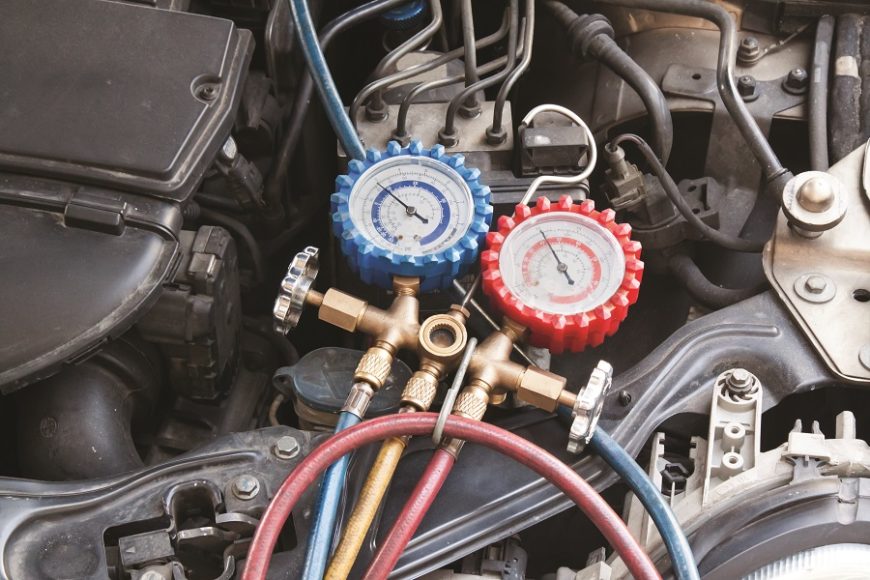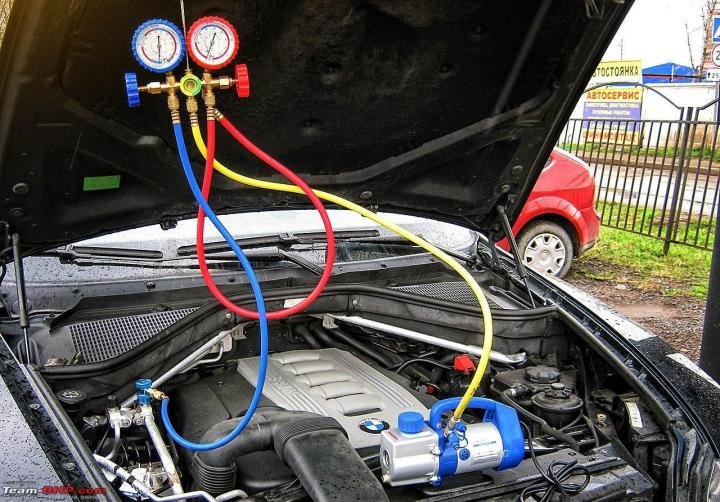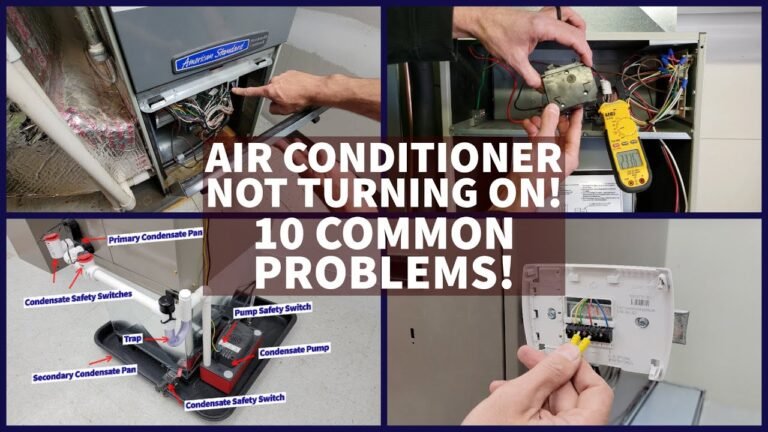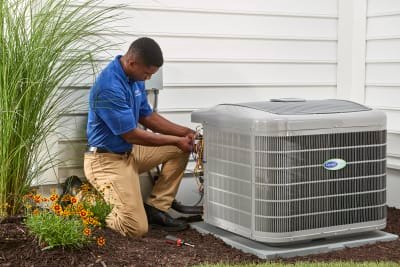How Does Air Conditioning Work in a Car: A Comprehensive Guide
Air conditioning in a car cools the interior by circulating refrigerant through a closed-loop system, removing heat and humidity while blowing cool air into the cabin. Driving comfort is enhanced by regulating the temperature and maintaining an ideal climate, regardless of external conditions.
Additionally, air conditioning systems help remove pollutants, allergens, and odors by filtering the air, contributing to healthier and cleaner cabin air quality. Maintaining the proper functioning of a car’s air conditioning system is crucial for optimal driving comfort and overall vehicle performance.
Regular maintenance, including checking refrigerant levels and system components, and addressing any issues promptly, ensures the longevity and efficiency of the air conditioning unit.

Credit: www.autozone.com
Components Of Car Air Conditioning System
Components of Car Air Conditioning System
An air conditioning (AC) system in a car consists of several components that work together to provide cool air and a comfortable environment inside the vehicle.
Compressor
The compressor is a vital component of the AC system. It is responsible for pressurizing and circulating the refrigerant, which is crucial for the cooling process. The compressor increases the refrigerant’s temperature and pressure, transforming it into a high-pressure gas.
Condenser
The condenser plays a significant role in the cooling process. It is located at the front of the vehicle and helps dissipate the heat from the high-pressure refrigerant, turning it into a high-pressure liquid.
Expansion Valve
Regulating the flow of refrigerant is the primary function of the expansion valve. It controls the amount of refrigerant entering the evaporator, ensuring proper cooling efficiency.
Evaporator
The evaporator is responsible for cooling the air inside the car. As the hot air passes through the evaporator, the refrigerant absorbs the heat, transforming into a low-pressure gas. This process cools the air, which is then circulated back into the car.
Refrigerant
The refrigerant plays a crucial role in transferring heat in the AC system. It undergoes a continuous cycle of phase changes and heat absorption, making it an integral part of the cooling process.
The Basic Principles Of Car Air Conditioning
The Basic Principles of Car Air Conditioning
A car air conditioning system works on the principles of refrigeration and heat exchange to keep the cabin cool and comfortable during hot weather.
Understanding the refrigeration cycle:
In a car air conditioning system, refrigerant gas is compressed and condensed to absorb heat from the cabin air. Then, it expands to evaporate and release the heat outside the car.
Pressure and temperature relationship in the air conditioning system:
As the refrigerant gas is compressed by the compressor, its pressure and temperature increase. Conversely, when it is expanded in the evaporator, the pressure and temperature decrease.
How the compressor compresses refrigerant gas:
The compressor in the air conditioning system pressurizes the refrigerant gas, raising its temperature and preparing it for the heat exchange process.
Heat exchange process in the condenser and evaporator:
In the condenser, hot pressurized refrigerant gas releases heat to the surrounding air, cooling down and turning into a high-pressure liquid. In the evaporator, this liquid evaporates, absorbing heat from the cabin air and turning into a low-pressure gas.
Expansion valve and its role in controlling refrigerant flow:
The expansion valve controls the flow of refrigerant, allowing a precise amount to enter the evaporator and regulate the cooling process.
Step-by-step Guide To How Air Conditioning Works In A Car
The air conditioning system in a car works by circulating refrigerant to absorb heat from the air and cool down the interior. It follows a step-by-step process to create a comfortable environment:
- Start with the refrigerant in a gaseous state: The air conditioning system begins with the refrigerant in a gaseous state within the system.
- The compressor compresses the refrigerant and raises its temperature: The compressor pressurizes the refrigerant, increasing its temperature.
- Hot refrigerant gas enters the condenser for heat dissipation: The hot refrigerant gas flows into the condenser where it releases heat and becomes a high-pressure liquid.
- The condenser cools the refrigerant and converts it into a liquid state: The condenser cools down the refrigerant further, causing it to condense and transform into a liquid state.
- Liquid refrigerant passes through the expansion valve, reducing its pressure: The liquid refrigerant moves through the expansion valve, where its pressure decreases.
- Low-pressure liquid refrigerant enters the evaporator: The low-pressure liquid refrigerant enters the evaporator, which is located inside the car.
- The evaporator absorbs heat from the air inside the car, cooling it down: The refrigerant in the evaporator absorbs heat from the air inside the car, resulting in cooler air.
- Cooled air is blown into the car’s interior through the vents: The cooled air is then distributed into the car’s interior through the vents.
- Warm refrigerant gas is sent back to the compressor to repeat the cycle: The warm refrigerant gas returns to the compressor to start the cycle again.
Common Issues And Troubleshooting Tips For Car Air Conditioning
Common Issues and Troubleshooting Tips for Car Air Conditioning:
Insufficient cooling and possible causes:
If your car’s air conditioning system is not cooling effectively, there could be several possible causes. A common issue could be a low refrigerant level, which may indicate a leak in the system. Another possible cause could be a faulty compressor or a problem with the condenser or evaporator. It is recommended to check for any visible signs of leaks or damage.
Air conditioner not blowing cold air and possible solutions:
If your air conditioner is not blowing cold air, it could indicate a refrigerant leak or a problem with the compressor. It is important to check the refrigerant levels and have any leaks repaired. Additionally, check the air filters as clogged filters can restrict airflow and affect cooling performance.
Unusual noises from the air conditioning system and troubleshooting tips:
If you notice any unusual noises coming from your car’s air conditioning system, it could be due to a worn-out belt, a faulty compressor, or a damaged fan. In such cases, it is advisable to have a professional inspect and diagnose the issue.
Foul odor from the air vents and how to eliminate it:
If you experience a foul odor coming from the air vents when using the air conditioner, it is likely due to the growth of mold and bacteria in the system. To eliminate the odor, you can use an air conditioning cleaner or have the system professionally cleaned and disinfected.
Refrigerant leaks and how to detect and repair them:
Refrigerant leaks can lead to the improper functioning of your car’s air conditioning system. Some signs of a refrigerant leak include reduced cooling performance and hissing sounds. To detect and repair the leak, it is recommended to consult a professional technician who can use specialized tools to locate and fix the issue.
Importance of regular maintenance for optimal air conditioning performance:
Regular maintenance is crucial for optimal air conditioning performance in your car. This includes checking and replacing air filters, inspecting and cleaning the condenser and evaporator coils, ensuring proper refrigerant levels, and lubricating moving parts. Regular maintenance can help prevent potential issues and ensure efficient cooling throughout the year.
Tips For Improving Car Air Conditioning Efficiency
Tips for Improving Car Air Conditioning Efficiency:
- Keep the car’s windows and sunroof closed while using the AC to prevent cool air from escaping and hot air from entering the vehicle.
- Park the car in shaded areas to reduce heat buildup inside the vehicle. This will help the AC work more efficiently and keep the cabin cooler.
- Use a sunshade or tinted windows to minimize heat transfer through the windows, reducing the load on the AC system.
- Clean or replace the air filters regularly to ensure proper airflow. Dirty filters can restrict the flow of air through the vents and reduce the AC’s efficiency.
- Avoid the recirculation mode for prolonged periods as it can cause a buildup of excess humidity inside the vehicle. Switch to fresh air mode intermittently to keep the cabin environment fresh.
- Schedule regular maintenance and inspections for the AC system to identify any potential issues early on. This will help maintain optimal performance and avoid costly repairs.
Frequently Asked Questions Of How Does Air Conditioning Work In A Car
How Does Air Conditioning Work In A Car?
Air conditioning in a car works by using a refrigerant to absorb heat from the cabin air and releasing it outside. The process involves compressing and condensing the refrigerant to cool it down, then expanding and evaporating it to absorb heat.
This cycle allows the air conditioner to maintain a comfortable temperature inside the car.
Why Is My Car’s Air Conditioning Not Cooling?
There could be several reasons why your car’s air conditioning is not cooling. It could be due to a refrigerant leak, a faulty compressor, a clogged condenser, or a malfunctioning blower motor. It is important to have your car’s air conditioning system inspected by a professional to diagnose the issue accurately and fix it.
How Can I Improve The Efficiency Of My Car’s Air Conditioning?
To improve the efficiency of your car’s air conditioning, you can:
– Park in shaded areas or use a sunshade to reduce heat buildup inside the car. – Clean or replace the cabin air filter regularly to ensure proper airflow. – Avoid setting the temperature too low; a moderate setting can be more efficient. – Have your system inspected and serviced regularly by a professional to maintain optimal performance.
Is It Normal For A Car’s Air Conditioning To Have A Smell?
No, it is not normal for a car’s air conditioning to have a smell. A foul odor could indicate the presence of mold or bacteria in the system. This can be caused by a dirty cabin air filter or moisture buildup in the evaporator.
It is recommended to have the system cleaned and inspected by a professional to eliminate the odor and ensure clean air circulation.
Conclusion
To sum up, understanding how air conditioning works in a car is essential for a comfortable driving experience. The process involves a combination of mechanical and chemical components that work together to cool and dehumidify the air inside the vehicle.
By maintaining proper maintenance and servicing of the AC system, you can ensure efficient operation and prolong its lifespan. Don’t forget to schedule regular inspections, as a professional can identify and address any potential issues before they become major problems.
With a fully functioning AC system, you’ll be able to stay cool and enjoy a pleasant journey on the road.







